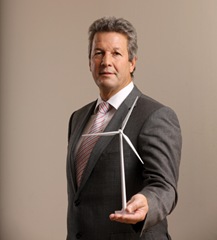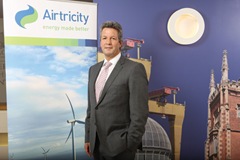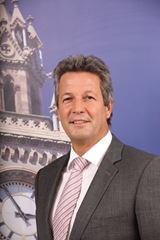Many firsts: Mark Ennis
 SSE Ireland’s Chairman, Mark Ennis, talks to Owen McQuade about the development of Airtricity from Iocal wind developer to a “full-blown” Irish energy utility.
SSE Ireland’s Chairman, Mark Ennis, talks to Owen McQuade about the development of Airtricity from Iocal wind developer to a “full-blown” Irish energy utility.
Airtricity has had many firsts in the energy sector. The company started in 1997 with the formation of Future Wind partnership, by Dr Eddie O’Connor “a true visionary”. As the name suggests, its purpose was to develop wind energy projects through partnerships. The partnerships approach, often in the form of joint ventures, has been the company’s way of doing business throughout its growth period.
Ennis explains that O’Connor started the company “to change the way electricity was delivered in Europe and for a company that started with nothing, that was quite a bold vision.” Some of O’Connor’s more radical ideas have since been adopted across Europe including his Supergrid concept for a grid around the North Sea.
In 1999 Irish infrastructure operator NTR invested in the then small local Irish wind developer, taking a 51 per cent equity stake. The company then entered a phase of strong growth and in 2002 Airtricity entered the Northern Ireland commercial electricity market. Ennis joined the company at that point.
He established the company’s commercial electricity supply, or retail, business in Northern Ireland which had been started in the Republic in 2000 to address a “chicken and egg situation.”
“We were developing a wind farm but had no customers and without customers there was no rationale to develop the wind farm,” he adds. The then regulator in Northern Ireland Douglas McIldoon agreed to sell renewable electricity contracted under the renewable energy obligation scheme from the North to supply Airtricity customers in the Republic to create a customer base that would in turn create a development base. “That was one of many firsts in the company’s development,” observes Ennis. At the end of that year he was running Airtricity’s supply business, North and South.
In a fund-raising round that year, the company was valued at €70 million and the company was sold in 2008 for €1.4 billion. Ennis says that this phenomenal amount of value came about because “the business was never built on creating financial reward but on the true belief we wanted to deliver wind energy.”
Just after joining the company, Ennis was informed by the network operator that there was no capacity available on the North/South electricity interconnector. It appeared that the company’s supply business was stopped in its tracks. Ennis met with the regulators on both sides of the border and the company created the concept of ‘superposition’ – another first for the industry – whereby flows north and south could be matched without the need to have an actual flow of power.
Airtricity’s next “battle” was the following year. With only 1 per cent wind on the system, a moratorium was declared on wind farm developments. “This actually worked for us in that it forced us to focus on developments outside Ireland, mostly in Scotland and the US.”
The company was also helped by another external development. At this time the price of oil started to rise. Ennis remembers speaking at the Energy Ireland conference in 2003 and forecasting $50 a barrel “and everyone laughing as the norm was $20 a barrel or less”. With prices peaking at $150 a barrel and $80 a barrel now normal, the period of higher oil prices has helped the development of wind energy and led to a period of strong growth for the company.
During this time, the company also started developing projects in the US, mostly in Texas. When the business was sold in 2008 it was sold in two parts: the US operations to E.on and European business to UK utility SSE. At the time of the sale its Irish operations consisted of 261 MW of operating wind farms with a pipeline of new projects totalling 900 MW.
At the time of the sale Airtricity had significant wind energy assets in UK, Ireland and the US and had developments in Spain, Portugal, Sweden and China.
Atlantic arc
With the purchase by SSE the emphasis changed. “With Airtricity, supply was a means to an end as we were primarily a global development business.” SSE purchased the company because of its renewable energy development capability and in the two years it has increased its assets in the Irish market to just under 500 MW with 1,200 MW in its development pipeline.
Within SSE the supply business is central which has meant a readjustment in Airtricity’s focus. It has sold off its wind assets in China and is rationalising its European assets. The key focus of SSE’s strategy is to have the UK business as a hub and then look at what can be interconnected to the UK: “Obviously Ireland, and hence the acquisition of Airtricity. Assets in Sweden and the Netherlands are still very relevant. Portugal less so and Italy even less so.” Ennis sums up SSE’s strategy as “to become a north west European energy utility”.
The utility’s strategy fits with a trend within the European energy market. There are a number of interconnector developments which are driving the move towards a North West European regional energy market. A consortium is promoting a Scotland-Norway interconnector and, in addition to the Ireland-UK interconnectors, there is the prospect of an Ireland-France link. “There is an ‘Atlantic arc’ starting to form which will include the assets in the Irish Sea. This gives an interesting power mix that could give the Irish consumer one of the most competitive energy sources in Europe,” says Ennis. “The mix would include hydro power from Scandinavia via its regional market, Nordpool, interconnection to the GB market and to French nuclear power.” Ennis says that there will be a strategic realignment of
Airtricity assets with disposal and acquisition over the next couple of years.
Structure
SSE has three main business platforms in Ireland: Airtricity the energy supply, or retail brand; SSE Renewables, the renewable energy development business; and Airtricity Utility Solutions, the street lighting and contracting business.
All three businesses have expanded significantly since the 2008 acquisition. The supply business had 35,000 customers, offering only electricity and had no domestic customers. Now, since entering the comprehensive domestic gas and electricity supply markets in both the Republic of Ireland and Northern Ireland, it has over 360,000 customers and is now the fastest-growing energy company in the market.
Airtricity, now under the SSE banner, has again been “a catalyst for change” in the Irish energy market. “As with any first mover in a market you come up against regulatory and system barriers, which is only natural, but they exist and you have got to take them on and change things.”
Each of the businesses in Ireland reports into the relevant business area in SSE headquarters in Perth, Scotland. Ennis says that when setting up the structure of the Irish operations there was also a need to co-ordinate each of the businesses from a country perspective and an advisory board was created for all the SSE business operations in Ireland. “It doesn’t interrupt the day-to-day operational lines but pulls everything together for a consistent approach on the island. What we are trying to do is complete the metamorphosis from a small Irish development company into a full Irish [energy] utility.”
In June of this year, Airtricity entered the Northern Ireland domestic electricity market and now has over 20,000 customers “despite having some significant regulatory and system barriers; no-one’s fault in particular, just those systems things you have to get over”.
With strong growth in recent years, especially through its retail brand, Airtricty, SSE is now a significant employer on the island, with over 900 staff in both the North and South. Despite the economic downturn, the company has created 500 jobs in its Dublin office over the last 18 months.
Airtricity Utility Solutions has had a “fantastic start.” The company now looks after over 300,000 street lights and has “made huge inroads into the quality of service.” Within its first year of operation the number of faults has been reduced by 50 per cent and the number of street lights with problems greater than 10 days has decreased by 30 per cent. This business was previously undertaken by ESB Contracts and taking over the business has meant taking on former ESB staff which “has gone fantastically well, with great support from the staff.” Ennis highlights this as “another example where competition has made a difference in the marketplace.”
One future challenge on which Ennis is focused, is to compete in the electricity distribution, or ‘wires’ business. The company has already had discussions
with the regulator in Northern Ireland to seek a distribution licence “but what we discovered was that there was no licence available.” Ennis highlights that not for the first time a barrier has to be overcome to enter a market, and true to form, there is now draft legislation with the Northern Ireland Executive to allow for the provision of an electricity distribution licence.
Ennis details the scale of the opportunity. There is currently an investment of €4 billion required in Ireland’s networks. If the renewable energy targets are to be met by 2020, an additional 1,250km will be required to facilitate the new generation onto the system.
Ennis believes that competition in new network build will drive down the cost of the regulated asset itself and therefore the return on the asset will be lower with less cost to the consumer. The company hopes to also compete with ESB Networks south of the border. It is “pushing quite hard to get into this space,” and is a key element of the company’s strategy of becoming a “full blown” Irish energy utility.
Mark Ennis was appointed Executive Chairman of SSE (Ireland) on 1 October 2010. Prior to joining Airtricity, Mark was CEO of Boxmore International PLC a manufacturer of packaging products for the pharmaceutical, agro-chemical and food sectors. The company was acquired by Chesapeake Corporation in 2000 and he was appointed Senior Vice-President of the company with responsibility for their global plastics division. He had a “lucky break” in that he had become disillusioned with his role and left, and therefore had the opportunity to join Airtricity.
Mark is a graduate in economics from Queen’s University Belfast with an MBA. He is married to Maureen with four children, Laura, Rachel, Richard and Harry and one grandchild. Interests outside work include competitive sailing, golf and skiing. He has a long-standing professional interest in leadership and management.






